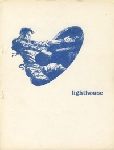Difference between revisions of "Lighthouse"
| (33 intermediate revisions by 3 users not shown) | |||
| Line 2: | Line 2: | ||
'''Lighthouse''' is a science fiction fanzine by Terry Carr. | '''Lighthouse''' is a science fiction fanzine by Terry Carr. | ||
| − | The first issue of ''Lighthouse'', published in 1958 by Terry Carr and Pete Graham, was intended | + | The first issue of ''Lighthouse'', published in 1958 by Terry Carr and Pete Graham, was intended to be a one-issue-only zine. At this time, Terry Carr was still publishing [[Innuendo]]. After relocating to New York, Graham revived ''Lighthouse'' and released two issues on his own as a [[Fantasy Amateur Press Association]] zine. When Terry Carr moved to New York in 1961, Graham offered him co-editorship of the zine. Later, Carr assumed editorship and Graham wrote a column for the zine. 15 issues were published in all. It was nominated for a Hugo Award for Best Fanzine for 1967 and 1968. |
| − | Contributions have included "Darkhouse" by Alva Rogers, his story of the SF crowd in the 1940s | + | Contributions have included "Darkhouse" by Alva Rogers, his story of the SF crowd in the 1940s when he was living in Jack Parson's house during the time Parsons was engaged with L. Ron Hubbard on the Alistair Crowley magical ritual known as the "Babylon Working". "Darkhouse" was later quoted extensively in the book ''Sex and Rockets: The Occult World of Jack Parsons''. |
| − | Also included is the article | + | Also included is the article "Drugs, Hallucinations and the Quest for Reality," by Philip K. Dick in the November 1964 issue, and "Will the Atomic Bomb Ever Be Perfected, and If So, What Becomes of Robert Heinlein?", which was first published in Lighthouse #14 (October 1966). |
| − | + | Along with Philip K. Dick and Alva Rogers, other contributing writers included Redd Boggs ([[The Lovecraftsman]], [[Shangri L'Affaires]]), Carol Carr, Sidney Coleman, [[Georgina Ellis|Gina Ellis]] ([[Descant]], [[Honque]], [[Queebshots]]), Pat Lupoff ([[Xero]], [[Horrib]]), Richard (Dick) Lupoff ([[Xero]], [[Horrib]]), George Metzger, Joanna Russ, [[Ted White]] ([[Stellar]]), [[Walt Willis]] ([[Hyphen]]), and [[Donald Wollheim]] ([[The Phantagraph]]). | |
| − | Contributing | + | Contributing artists included [[Arthur Thomson|Arthur Thomson (ATOM)]], [[Hannes Bok]], Jack Gaughan, and Ray Nelson. |
| − | + | Peter Graham and Terry Carr were also co-editors of [[Void]], along with Gregory Benford and [[Ted White]]. Terry Carr also published the fanzines [[Klein Bottle]], with [[Miriam Dyches/Carr/Knight/Lloyd|Miriam Carr]], and [[Innuendo]], with Dave Rike. He also released the one shot [[Entropy (U.S.A.)|Entropy]] during the run of ''Lighthouse''. | |
[[Category:Zine]] | [[Category:Zine]] | ||
| Line 20: | Line 20: | ||
[[Category:Science Fiction Zines]] | [[Category:Science Fiction Zines]] | ||
[[Category:Apazine]] | [[Category:Apazine]] | ||
| + | [[Category:Fantasy Amateur Press Association]] | ||
Latest revision as of 04:39, 16 March 2014
Lighthouse is a science fiction fanzine by Terry Carr.
The first issue of Lighthouse, published in 1958 by Terry Carr and Pete Graham, was intended to be a one-issue-only zine. At this time, Terry Carr was still publishing Innuendo. After relocating to New York, Graham revived Lighthouse and released two issues on his own as a Fantasy Amateur Press Association zine. When Terry Carr moved to New York in 1961, Graham offered him co-editorship of the zine. Later, Carr assumed editorship and Graham wrote a column for the zine. 15 issues were published in all. It was nominated for a Hugo Award for Best Fanzine for 1967 and 1968.
Contributions have included "Darkhouse" by Alva Rogers, his story of the SF crowd in the 1940s when he was living in Jack Parson's house during the time Parsons was engaged with L. Ron Hubbard on the Alistair Crowley magical ritual known as the "Babylon Working". "Darkhouse" was later quoted extensively in the book Sex and Rockets: The Occult World of Jack Parsons.
Also included is the article "Drugs, Hallucinations and the Quest for Reality," by Philip K. Dick in the November 1964 issue, and "Will the Atomic Bomb Ever Be Perfected, and If So, What Becomes of Robert Heinlein?", which was first published in Lighthouse #14 (October 1966).
Along with Philip K. Dick and Alva Rogers, other contributing writers included Redd Boggs (The Lovecraftsman, Shangri L'Affaires), Carol Carr, Sidney Coleman, Gina Ellis (Descant, Honque, Queebshots), Pat Lupoff (Xero, Horrib), Richard (Dick) Lupoff (Xero, Horrib), George Metzger, Joanna Russ, Ted White (Stellar), Walt Willis (Hyphen), and Donald Wollheim (The Phantagraph).
Contributing artists included Arthur Thomson (ATOM), Hannes Bok, Jack Gaughan, and Ray Nelson.
Peter Graham and Terry Carr were also co-editors of Void, along with Gregory Benford and Ted White. Terry Carr also published the fanzines Klein Bottle, with Miriam Carr, and Innuendo, with Dave Rike. He also released the one shot Entropy during the run of Lighthouse.
